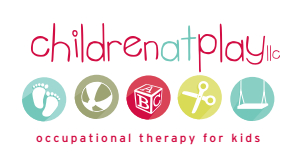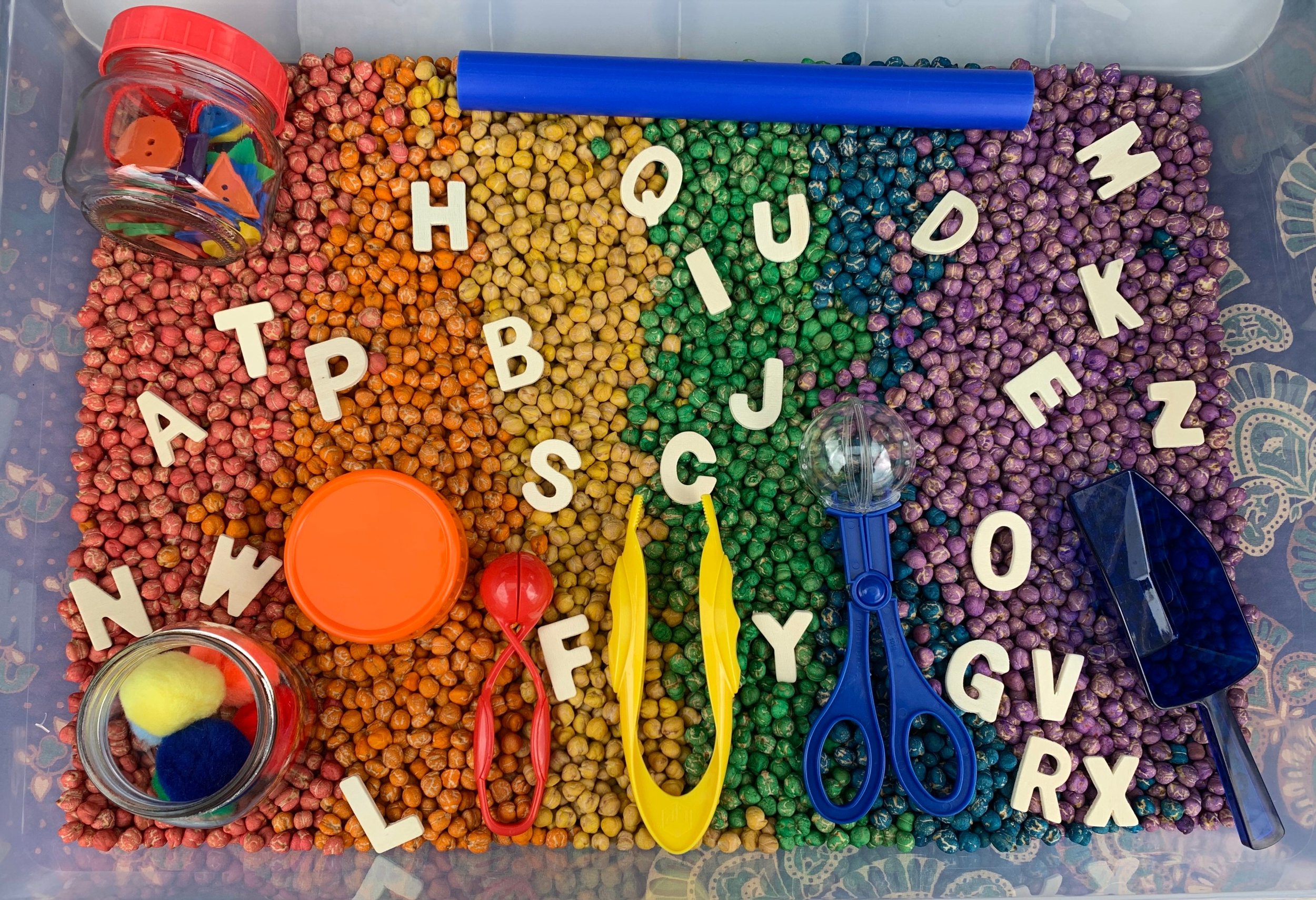One of our favorite options to work on children's developmental skills is a sensory bin! Sensory bins provide kids with hands-on sensory experiences and create a multitude of learning and development opportunities. If you’d like to skip to the instructions on how to make a sensory bin, scroll to the bottom.
THE BENEFITS OF sensory bins
Self-regulation and attention
Sensory bins can be a helpful tool for calming and regulation. When digging through the sensory bin, the tactile and proprioceptive input your child's body receives helps to organize and regulate their body. Some children benefit from using a bin filler with more weight to increase the deep pressure and heavy work(proprioceptive input). This input also improves body awareness which is essential for self-regulation. Engaging in repetitive fine motor activity can sometimes be calming for children who may be overstimulated by tactile input. For example, picking up small objects in the bin one at a time and placing them in a small container or opening.
Sensory bin play is also a great way to improve sustained attention. Many children demonstrate increased engagement while playing in a sensory bin due to its self-regulating effects. Incorporate a sorting task or game during this playtime for children who need added assistance with building a longer attention span.
Fine motor skills
Sensory bin play provides opportunities for children to improve their fine motor skills. While picking up and manipulating small items in the bin, they can enhance their grasp pattern, in-hand manipulation, strength, and coordination. Incorporating tools (i.e., spoons, tweezers, tongs) can facilitate efficiency with utensils and increased hand strength. Using scoops or a shovel in one hand to scoop contents and pour them into a cup held by the other hand practices bilateral manipulation. Cleaning up the small pieces that may come out of the bin while playing with their fingers using a pinching grasp is more fine motor practice that doesn't usually require any extra planning.
Cognitive Tasks/Language Development
A sensory bin full of objects allows you to create learning opportunities. Encourage your child to sort items by color, shape, size, preference, or any other category to enhance cognitive skills further.
You can also help your child describe what they are experiencing through their body sensations to help develop language skills. Learning descriptive words such as rough, smooth, wet, sweet, fragrant, and many others will increase your child's vocabulary.
Visual Perceptual Skills
Make these skill-building tasks even more fun by turning them into an "I-Spy" game. Children must access their visual perceptual skills to look for and find small items hidden in the bin. Working on visual perceptual skills carries over into everyday activities such as dressing, eating, handwriting, playing, etc.
Play Skills/Social Interaction
Engaging in sensory bin play provides the child with independent and cooperative play opportunities. Sensory bins may be used in the classroom, in a group setting, or at home with a parent or friend. Try modeling and expanding on your child's play ideas when playing with your child at home. Some ideas include "feeding" contents to animals in the bin or pretending the bin is a construction site for trucks.
Sensory bins can be a great way to build social interaction skills through exploratory play when used with one or multiple friends. Children can practice communicating ideas, sharing, taking turns, and working as a team. These social skills set the foundation for how children relate to their peers, siblings, caregivers, and educators.
Sensory Exploration
Playing in sensory bins can involve multiple senses at once; touch, sight, sound, smell, taste, and proprioceptive input.
Touch
Sensory bins can be helpful for both tactile-seeking behaviors and tactile defensiveness. Some kids are sensory seekers and are constantly looking for that tactile input. They love the sensation of burying their hands or feet in a bin of dry rice, sand, or water beads. Sensory bin play allows children to receive the sensory input their bodies require in a safe and fun way. On the other hand, some children become dysregulated when presented with certain tactile textures. These are our tactile defensive kids. Sensory bins are a fun way to increase their tolerance for textures. It may be beneficial to begin with a dry filler in your bin and progress towards wet/sticky fillers such as water beads or shaving cream.
Sight
Part of making your sensory bin is deciding what type of visual input your child benefits from. The bin can have a large variety of colors and objects. If less visual stimulation is needed, monochromatic or muted colors in the bin may be more appropriate.
Sound
Your child's sense of sound is activated as they run their hands through the sensory bin's contents, scoop and pour fillers and toys, or shake a cup or jar filled with the beans. Various fillers make different amounts of sound. Waterbeads are quiet; chickpeas are louder.
Smell
A fun way to incorporate scents to activate those senses is to add essential oils to the bin's filler; for example, lavender for calming, lemon or eucalyptus for energizing.
Taste
Using a "taste-safe" sensory bin is a great way to activate those taste buds and receive sensory input through the mouth.
Proprioception
The proprioceptive system allows our bodies to process input from sensory receptors in our muscles and joints. This system is activated when we push or pull on objects when our joints are compressed (jumping up and down) and when they are pulled apart (hanging from monkey bars). Sensory bin play is a great way to receive proprioceptive input through the upper body's muscles and joints. Adding play tools like scoopers and grippers and using heavy mediums in your sensory bins are all ways to increase that input. You don't need to target each sensory area simultaneously; you can alternate fillers and items in the bin and incorporate various activities in your child's sensory bin play.
How to Make a Sensory Bin
Choose a bin - We recommend a bin with side locks to keep contents securely covered and prevent surprise messes. Clear storage containers work best as they allow children to see inside. Around 32 qts is usually a good size. Smaller bins require less filler and are a bit cheaper. Larger bins allow for multiple children to have space to play.
Choose a theme - Your sensory bin theme can be seasons, holidays, characters, habitats, etc. You can choose any theme or start with what you already have at home. Our Pinterest page has some ideas.
Choose a filler - there are many different mediums to choose from. Our favorites include dried beans/chickpeas, rice, water beads, or kinetic sand. Decide if you want a heavier medium(large dried beans) or a lighter option(dried rice) based on your child's sensory needs. Some taste-safe filler options include cereal, crushed graham crackers for "edible sand", raw oatmeal, cooked pasta, or jello.
Choose your tools - some options may include a small shovel, scooper, measuring cups, spoon, tongs, cookie cutters, tubes, or funnels. This fine motor tool set is a good starter kit.
Choose your toys - add figurines/small themed items into the sensory bin based on your chosen theme to add texture and visual appeal.
For some of our favorite tools and toys to use in sensory bins, such as pinchers and scoops, check out the Our Favorites page.
Remember: It's essential only to include items in the bin that are safe for the developmental stage of the child/children that will be playing with the sensory bin. Supervision is recommended, especially for those who frequently put objects in their mouth.





